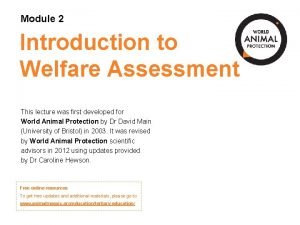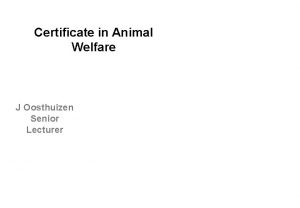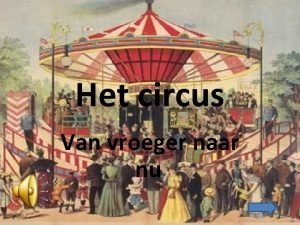Animal Welfare Issues with the Circus Kyrsti Cotton









- Slides: 9

Animal Welfare Issues with the Circus Kyrsti Cotton

History of the Circus John Bill Rickets, an English equestrian rider brought the circus to the U. S. April 3, 1793. He rode in a ring, had acrobats, a rope walker and a clown. Hackaliah Bailey, a New York farmer who’s brother was a sea captain. Bailey’s brother bought a female African elephant at an auction in London for $20 and sold it to Bailey for $1, 000. When Old Bet reached the U. S. Bailey walked her 56 miles along the Hudson river at night, so people couldn’t see her. Every day he’d charge people a fee to see her. In the 1820’s people began having traveling menageries of exotic animals. In 1930 they started combining animals with the circus acts. Isaac van Amburgh started with the giant cats in 1833. He would beat them into compliance with a crowbar and put his arm in their mouth daring them to bit him. Golden age of the circus was in the 1850’s. Countries most popular entertainment. Before 1869 all traveling was done with the animals in small cages on wagons or by boat. When the Union Pacific and Central Pacific railroads joined traveling was much faster. Ringling Brothers Circus became the most popular circus in history

5 Welfare Concerns 1. Accommodation- Wild animals are more dangerous and unpredictable, so they have stricter rules. Smaller enclosures for large animals limit normal behavior, enrichment is not possible, animals display apathetic and abnormal behaviors. 2. Transport- Animals are transported often and in small cages. Transport is stressful for the animals and they constantly have to adapt to a new environment that in normal life might be considered dangerous. 3. Training- Animal welfare people believe that it is trough torture that the animals are trained. An animal would not normally jump through fire. Cats are self-willed and don’t really perform for reward. The trainer must be the dominant over each animal and force must be used in some cases. Reward system of training should be used that doesn’t cause stress. 4. Performance- Animals must be assumed to enjoy performing, but that may not be true. Acts are routine and compulsive, causing boredom and aversion. 5. Winter Housing- Animals have to adjust to climates they aren’t use to. They are in small enclosures sometimes so climatic-conditions can be controlled, but restrict movement or are outside in the cold.

Massachusetts Society for the Prevention of Cruelty to Animals (MSPCA) Certain states prohibit circuses from coming into them. Animal Welfare Act requires a minimum of standards of care and treatment be provided, but circuses violate quite a few. Reasons: Animals travel every week Forced separation from herds and babies Chained when not performing Restrictive caging, stand lay down in their own waste Coercive training methods Tricks are frightening, unnatural, painful Bullhooks and other prods are used in training No climate control during transport and housing. Animals hurt their trainers Some get loose and cause accidents and injure others.

People for the Ethical Treatment of Animals (PETA) Animals access to basic necessities: food, water, vet care is inadequate. Large and normally active animals spend their lives in cramped, barren cages/trailers. Only room to stand turn around. Elephants kept in leg shackles Primates are highly social, intelligent, and caring. Animals winter in barns, traveling crates, trucks. They suffer social depravation and have nothing to engage their brains in. Un-natural behavior-head bobbing, swaying, prancing, pacing Training tools-whips, tight collars, muzzles, electric prods, bullhooks. Teeth and claws removed making it hard for animals to eat. Performances do nothing to teach the public about animals normal behavior. Many cases have been recorded about the animals snapping under pressure.

Support for the Circus Hundreds of people will be out of jobs Some animals have already been retired to animal sanctuaries Private owners keep their animals Sanctuaries are filling up, so it is becoming harder to place the animals, especially the big cats. Sanctuaries do not have enough money sometimes to provide for all the animals they take in. Circuses aid in conservation due to breeding programs and raising awareness. Circuses are great entertainment for children. If the circus is shut down then zoos, aquariums, horseracing, meat consumption and animal research would be next to shut down. The circus is a 250 year old art form that has been a major source of entertainment for generations.

Closing the Circus The Circus is officially closing in May Between 40 -50 animals, including 18 tiger have to find new owners. Tigers, camels, horses, llamas, goats, lions, elephants, primates are all in the process of being relocated. Company owned animals will be moved to zoos and conservation centers 11 elephants have been moved already to spend the rest of their days in the Ringling’s Center for Elephant Conservation in Florida.


References http: //www. history-magazine. com/circuses. html http: //animalfreedom. org/english/information/circus_animals. html https: //www. mspca. org/animal_protection/circus-animal-welfare/ http: //www. peta. org/issues/animals-in-entertainment/animals-usedentertainment-factsheets/circuses-three-rings-abuse/ https: //www. washingtonpost. com/news/animalia/wp/2017/01/19/oneproblem-with-shutting-down-the-circus-where-will-the-animalsgo/? utm_term=. 2 c 43 cfddc 96 f http: //www. huffingtonpost. co. uk/douglas-mcpherson/circus-animals-10 reasons_b_6768110. html
 Venn diagram plant vs animal cells
Venn diagram plant vs animal cells Animal rights versus animal welfare
Animal rights versus animal welfare Venn diagram of organelles in plant and animal cells
Venn diagram of organelles in plant and animal cells Giza cotton vs pima cotton
Giza cotton vs pima cotton Cotton on the roadside cotton in the ditch
Cotton on the roadside cotton in the ditch Welfare inputs and outputs
Welfare inputs and outputs Higher certificate in animal welfare
Higher certificate in animal welfare Welpets
Welpets The butterfly circus questions and answers
The butterfly circus questions and answers Operant conditioning edward thorndike
Operant conditioning edward thorndike

















